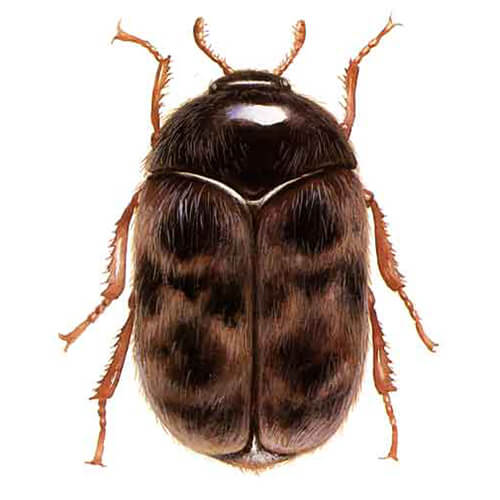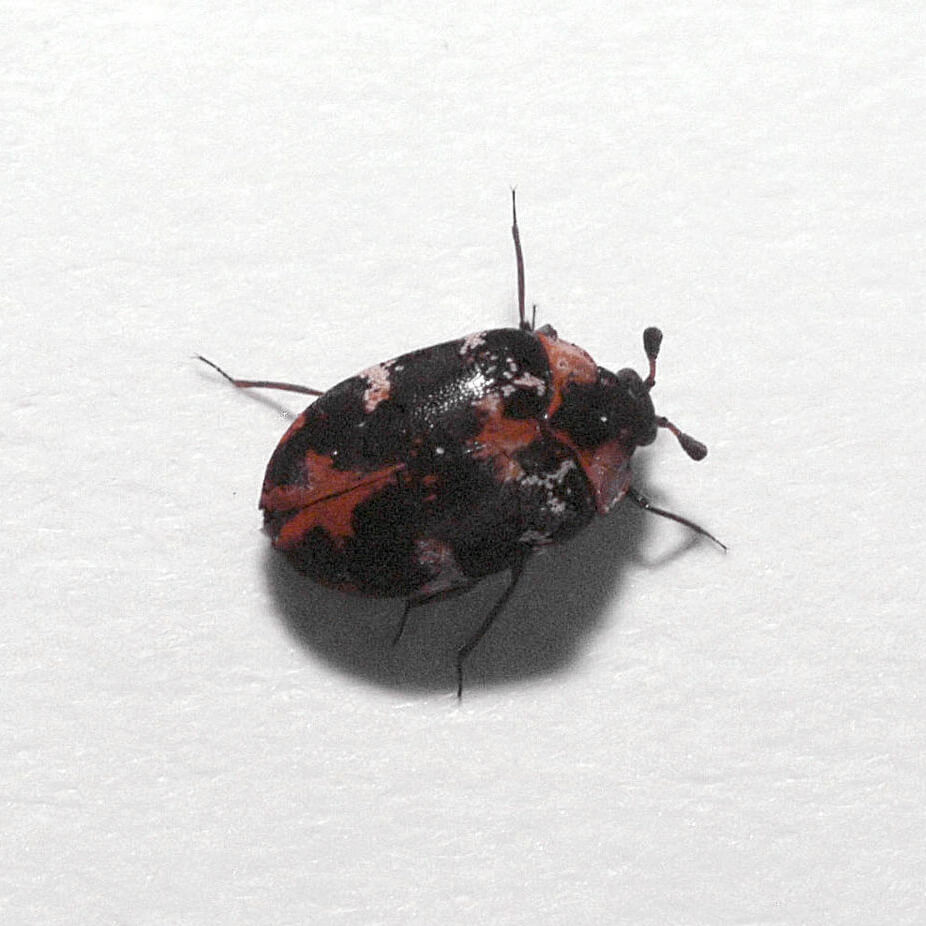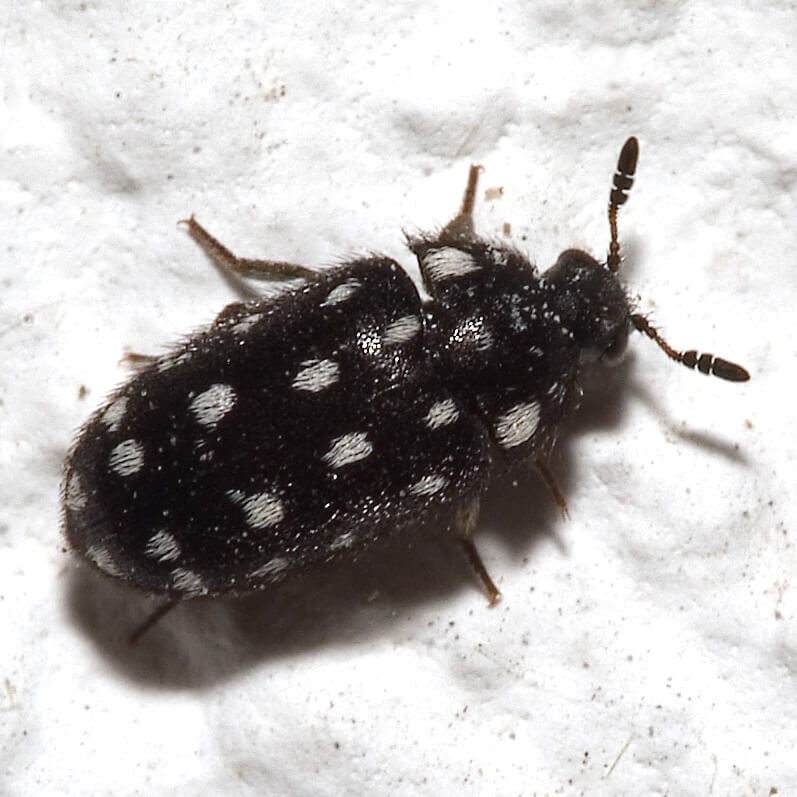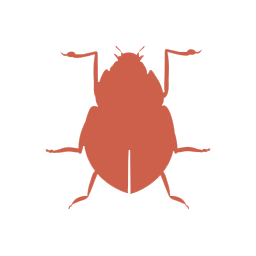Carpet Beetle Control Guide
Carpet beetles, often overlooked but a common household nuisance, are small insects that can wreak havoc on your home’s textiles. These tiny pests have a penchant for feasting on natural fibers, such as wool and cotton, causing damage to carpets, upholstery, and clothing. Preventing a carpet beetle infestation is crucial to safeguard your prized possessions. Regular cleaning, proper storage, and professional pest control services can help keep these unwelcome guests at bay, ensuring the longevity and beauty of your cherished fabrics. Don’t let carpet beetles become a silent threat; take proactive measures to protect your home and belongings.
The different species of carpet beetle
The most common species of carpet beetles include:

Anthrenus verbasci (Varied Carpet Beetle)
This species is known for its varied coloration and is a frequent household pest, feeding on natural fibers and stored food products.

Trogoderma granarium (Khapra Beetle)
Khapra beetles are more of a concern in agricultural and food storage settings, as they infest stored grains and dried food products.

Anthrenus scrophulariae (Black Carpet Beetle)
Black carpet beetles are dark in color and can infest carpets, upholstery, and clothing, causing damage to natural fabrics.

Dermestes maculatus (Hide or Leather Beetle)
These beetles have a penchant for animal products like leather, hides, and furs, and can also be found in museums damaging preserved specimens.

Attagenus unicolor (Attagenus Beetle)
These beetles are often found in attics and can be particularly destructive to textiles and natural fibers.
It’s important to be vigilant and take preventive measures to protect your home and belongings from these common carpet beetle species. Regular cleaning, proper storage, and professional pest control can help keep infestations at bay.
There are over 1,000 species of carpet beetles, with varied appearances and behaviors.
The life cycle of carpet beetle
The life cycle of a carpet beetle is a fascinating yet potentially problematic journey. These tiny insects go through four distinct stages: eggs, larvae, pupae, and adults.

Egg Stage
It all begins when the female carpet beetle lays her eggs, often in hidden, secluded areas within your home. These eggs are minuscule and can be easily overlooked.

Pupae Stage
After the larval stage, carpet beetles enter the pupal stage, where they undergo metamorphosis. During this period, they are immobile and encased in a protective cocoon.

Larval Stage
When the eggs hatch, they give rise to carpet beetle larvae. These larvae are the culprits behind the damage to your textiles. They’re hungry and feed voraciously on natural fibers like wool, silk, and even stored food items. This stage can last several months, depending on environmental conditions and the availability of food.

Adult Stage
Finally, the adult carpet beetles emerge from their pupae as fully formed insects. They are small, typically ranging from 1 to 4 millimeters in size, and often possess distinctive patterns on their wings. Unlike the destructive larvae, adult carpet beetles primarily focus on reproducing and do not feed on textiles.
Understanding the life cycle of carpet beetles is crucial for effective pest control and prevention. Regular cleaning, sealing potential entry points, and maintaining a clean and organized environment can help break the cycle and keep these pests at bay. By staying informed about their life stages, you can better protect your home and cherished belongings from carpet beetle infestations.
The larvae of carpet beetles are responsible for most of the damage to textiles, as they feed on natural fibers.
The seasons most conducive to carpet beetle
Carpet beetles are active year-round, but certain seasons can be more conducive to their prevalence and activity. In many regions, the late spring to early summer and early fall are the seasons when carpet beetles tend to be most active and problematic.

Spring
As temperatures rise in late spring, carpet beetles become more active. They emerge from their dormant winter state and begin searching for food sources and suitable breeding grounds. During this time, they may infest stored textiles, carpets, and other natural fiber products.
Summer
Throughout the summer months, carpet beetles continue their activity, especially if the environment provides favorable conditions such as warmth and humidity. The larvae, which cause the most damage, actively feed and grow during this time.

Early Fall
In early fall, carpet beetles often seek out sheltered locations to overwinter. They may find their way indoors, seeking refuge from the cooler outdoor temperatures. This can lead to increased indoor infestations as they look for suitable places to hibernate.
To prevent carpet beetle infestations, it’s essential to maintain a year-round strategy for pest control and prevention. Regular cleaning, proper storage of textiles, and sealing entry points can help reduce the risk of these pests becoming a problem in your home. Staying vigilant during the seasons when carpet beetles are most active can go a long way in safeguarding your belongings and living spaces.
Late spring and early fall are the peak seasons for carpet beetle infestations due to increased activity.
Where do carpet beetle come from, their habitat.
Carpet beetles originate from the outdoors and are natural inhabitants of various environments. Their habitat and source can be traced back to a wide range of locations, both in nature and inside homes:

Outdoors
Carpet beetles often live in natural outdoor environments. They can be found in bird nests, beehives, and animal burrows, where they feed on organic materials such as feathers, fur, and dried plant matter. Adult carpet beetles may enter homes from outside in search of suitable breeding and feeding grounds.

Indoors
Once inside a home, carpet beetles seek refuge and nourishment. They are attracted to natural fibers and stored food products. These pests can hide in dark, undisturbed areas like closets, attics, and basements, making these places their indoor habitat.

Infested Items
Infestations can also originate from infested items that are brought into the home. Purchasing second-hand clothing, vintage furniture, or rugs may introduce carpet beetles if these items are already infested.
Understanding the sources and habitats of carpet beetles is crucial for effective pest control and prevention. Regular cleaning, maintaining cleanliness and organization in storage areas, and sealing potential entry points can help keep these pests from becoming a problem in your home. Additionally, inspecting second-hand items before bringing them indoors can prevent infestations from starting in the first place.
Carpet beetles are adept at hiding in dark, undisturbed areas, making them challenging to detect.
What attracts carpet beetle into our homes
Carpet beetles are attracted to our homes primarily by the presence of specific factors and materials that serve as their sources of food and shelter. Understanding what draws them in can help in implementing effective prevention measures:
Natural Fibers
Carpet beetles are primarily attracted to natural fibers like wool, silk, cotton, and fur. Items such as carpets, upholstered furniture, curtains, clothing, and blankets made from these materials provide an ample food source for the larvae.
Warmth and Shelter
As temperatures drop, especially in cooler seasons, carpet beetles may seek shelter indoors. Dark, undisturbed areas like closets, attics, and basements provide a suitable refuge.
Stored Food Products
Some carpet beetle species, like the Khapra beetle, are attracted to stored food products such as grains, cereals, and dried pet food. They may find their way into kitchens and pantries in search of these food sources.
Second-Hand Items
Bringing second-hand items into your home, such as vintage clothing or used furniture, can introduce carpet beetles if these items are already infested.
Animal Byproducts
Carpet beetles are also drawn to animal-based products like feathers, leather, and animal hides. Taxidermy specimens, woolen rugs, or even pet bedding can be potential attractants.
To prevent carpet beetle infestations, it’s crucial to store natural fiber items properly, maintain cleanliness, and regularly clean and vacuum your home. Sealing entry points, inspecting second-hand items, and implementing effective pest control measures can all help in deterring these pests from entering and infesting your home.
The bristle-like hairs of carpet beetle larvae can become airborne allergens, causing respiratory issues in sensitive individuals.
Signs that you have a carpet beetle’ infestation
Detecting a carpet beetle infestation early is essential to prevent damage to your belongings. Here are some common signs that you may have a carpet beetle infestation:
Visible Beetles
One of the most obvious signs is the presence of adult carpet beetles. These small, oval-shaped insects are typically 1 to 4 millimeters in size and may be found crawling on surfaces in your home.
Fecal Pellets
Tiny, powdery, and brown fecal pellets left behind by the larvae can accumulate on or around infested materials. These pellets are a sign of their feeding activity.
Infestations in Dark Areas
Carpet beetles prefer dark and undisturbed areas, so check in closets, attics, and basements for signs of infestation.
Larval Skins
Shed skins of carpet beetle larvae are often left behind as they grow. These tiny, brown, and segmented casings can be found near infested materials.
Cast Skins
As carpet beetle larvae grow, they shed their exoskeletons, which can be found near their feeding areas.
Presence of Nests
If you have bird nests or beehives near your home, you may be more susceptible to carpet beetle infestations, as they often inhabit these environments.
Damage to Fabrics
Carpet beetle larvae feed on natural fibers. Look for irregular holes or damage in clothing, carpets, upholstery, and linens. This type of damage can be a clear indication of infestation.
Adult Beetles Near Windows
Adult carpet beetles may be attracted to light and can be found near windows, especially in the spring and early summer.
Stored Food Damage
If you notice damage to stored food products like grains, cereals, or dried pet food, it could be a sign of infestation, especially if you’re dealing with species like the Khapra beetle.
If you notice damage to stored food products like grains, cereals, or dried pet food, it could be a sign of infestation, especially if you’re dealing with species like the Khapra beetle. If you observe any of these signs, it’s essential to take prompt action to address the infestation. Thorough cleaning, proper storage, and, if necessary, professional pest control services can help eliminate carpet beetles from your home and prevent further damage.
As carpet beetle larvae grow, they shed their exoskeletons, leaving behind tiny casings near their feeding areas.
Rooms where carpet beetle hide
Carpet beetles are known to infest various areas of a home, as they feed on a wide range of organic materials.

Living Rooms
Carpet beetles can infest carpets, upholstery, and curtains in living rooms.
Closets
Stored clothing, blankets, and linens in closets are susceptible to infestation.
Kitchens
While less common, they can infest the kitchen, especially pantry items like grains and cereals.
Laundry Rooms
Stored clothing, especially if damp, can be infested.
Bedrooms
They are often found in bedrooms, particularly in carpets, bedding, and stored clothing.
Basements
Carpet beetles can be found in basements, especially if there are stored items like old books or clothing.
Bathrooms
In bathrooms, they may infest towels, bathmats, and even toilet paper if not stored properly.
Dining Rooms
Carpet beetles may infest dining room rugs, tablecloths, and upholstered furniture.
Attics
Attics may house carpet beetles if there are natural fibers, insulation materials, or stored belongings.
Garages
Carpet beetles can be found in garages where old furniture, textiles, or boxes are stored.
Remember that carpet beetles feed on natural fibers, such as wool, silk, and cotton, and other organic materials, including hair, pet dander, and feathers. Proper cleaning, storage, and maintenance can help prevent carpet beetle infestations.
The dangers and damages that ticks can cause
Carpet beetles may seem small and inconspicuous, but they can cause significant damage and pose various dangers within your home:
Textile Damage
One of the most significant dangers is the damage they inflict on textiles. Carpet beetle larvae feed on natural fibers like wool, silk, cotton, and fur. They can chew through clothing, carpets, upholstery, curtains, blankets, and more, leaving behind irregular holes and unsightly damage.
Food Contamination
Some carpet beetle species, like the Khapra beetle, are known for infesting stored food products. They can contaminate grains, cereals, and dried pet food, rendering them unsafe to consume.
Costly Repairs
Repairing or replacing damaged items and textiles can be costly. Carpet beetle infestations can lead to unexpected expenses for homeowners.
Secondary Pest Infestations
Carpet beetles can introduce other pests into your home. For example, they may bring in mold or mildew as they feed on moisture-prone materials.
Allergens
Carpet beetle larvae shed tiny, bristly hairs that can become airborne and act as allergens. These hairs may trigger allergies or respiratory issues in sensitive individuals.
Property Damage
Beyond textiles, carpet beetles may damage other materials such as feathers, leather, and animal hides. Taxidermy specimens, antique furniture, and other valuables can be affected.
Emotional Distress
Discovering damage to cherished or sentimental items can be emotionally distressing. It can be disheartening to find that valuable possessions have been ruined by these pests.
Difficulty in Eradication
Eliminating carpet beetle infestations can be challenging, as they often hide in concealed areas. DIY efforts may not be sufficient, and professional pest control services may be required.
Understanding the dangers and potential damages caused by carpet beetles underscores the importance of early detection and effective prevention measures. Regular cleaning, proper storage, and vigilant maintenance can help safeguard your home and belongings from these destructive pests.
Proper storage, regular cleaning, and sealing entry points can effectively prevent carpet beetle infestations.
How to get rid of carpet beetle / Available treatments.
Getting rid of a carpet beetle infestation involves a combination of preventive measures and treatments to eliminate these pests from your home. Here are some effective strategies and available treatments to combat carpet beetles:
Identify the Source
Start by identifying the source of the infestation and the areas where carpet beetles are hiding. Inspect closets, basements, attics, and other storage areas.
Launder and Freeze
Wash and dry infested clothing, linens, and fabrics at high temperatures to kill larvae and eggs. If the items cannot be washed, you can freeze them at temperatures below 0°F (-18°C) for several days to eliminate any pests.
Use Pesticides
In severe infestations, consider using insecticides. Always follow label instructions and use these products safely. Be cautious when applying pesticides near areas where food is stored or where pets and children frequent.
Prevent Reinfestation
After eliminating the infestation, implement preventive measures to avoid future carpet beetle problems. Store clothing and textiles in airtight containers, keep your home clean and well-ventilated, and inspect second-hand items for signs of infestation before bringing them inside.
Clean and Declutter
Thoroughly clean and declutter your home, removing potential food sources for carpet beetles. Vacuum all affected areas, including carpets, upholstery, and crevices.
Seal Entry Points
Seal any potential entry points where carpet beetles may be getting into your home, including cracks and gaps in walls, windows, and doors.
Professional Pest Control
If the infestation is extensive or persists despite your efforts, it’s advisable to seek the services of a professional pest control company. They have the expertise and access to stronger treatments to effectively eradicate the problem.
Use Natural Remedies
Some natural remedies like diatomaceous earth or boric acid can be applied to areas where carpet beetles hide. These substances are abrasive and can help dehydrate and kill the pests.
Remember that prevention is key to avoiding carpet beetle infestations. Maintaining a clean and organized home, proper storage of textiles, and sealing entry points can help keep these pests at bay. If you suspect a severe infestation or are unsure how to proceed, consult a pest control professional for expert guidance and treatments.
Some carpet beetle species, like the Khapra beetle, are notorious for infesting stored food products, rendering them unsafe to consume.
How to prevent carpet beetle infestations
Preventing carpet beetle infestations is the most effective way to avoid the damage and nuisance they can cause. Here are some proactive measures you can take to prevent carpet beetle infestations in your home:
Regular Cleaning
Keep your home clean and well-maintained. Vacuum carpets, rugs, and upholstery regularly, paying close attention to hidden or less frequently used areas.
Inspect Second-Hand Items
Before bringing second-hand clothing, furniture, or textiles into your home, inspect them for any signs of infestation. This includes looking for shed skins, fecal pellets, or live beetles.
Reduce Humidity
Keep indoor humidity levels low, as high humidity can attract carpet beetles. Use dehumidifiers in areas prone to excess moisture.
Bird Nests and Beehives
If you have bird nests or beehives on your property, consider addressing them to reduce the potential attraction of carpet beetles.
Dust and Debris Removal
Regularly clean and dust all surfaces, as carpet beetles are attracted to accumulated dust and debris.
Seal Entry Points
Seal any cracks, gaps, or openings around windows, doors, and other entry points to prevent carpet beetles from entering your home.
Rotate Stored Items
Periodically rotate stored items, such as clothing and linens, to disturb potential hiding places for carpet beetles.
Professional Pest Control
Consider scheduling regular pest control inspections to catch potential infestations early or to implement preventive treatments.
Proper Storage
Store clothing, blankets, and other textiles in airtight containers, especially when not in use. Use plastic bins or vacuum-sealed bags to protect these items.
Maintain Adequate Ventilation
Ensure proper ventilation in your home, as carpet beetles are less likely to infest in well-ventilated spaces.
Inspect Natural Fiber Materials
Inspect natural fiber items like wool rugs, fur, and feathers regularly for any signs of infestation.
By taking these preventive measures, you can significantly reduce the risk of carpet beetle infestations and protect your home and belongings from these pests. Consistency in cleanliness, proper storage, and vigilance in inspecting new additions to your home are key to keeping carpet beetles at bay.
Conclusion
In conclusion, understanding the habits, dangers, and prevention of carpet beetles is essential for safeguarding your home and cherished belongings. Carpet beetle infestations can be a source of frustration and costly damage, but with proactive measures like regular cleaning, proper storage, and professional pest control when needed, you can effectively protect your living spaces from these persistent pests. Stay informed, stay vigilant, and ensure a beetle-free environment for a more comfortable and worry-free living experience.
